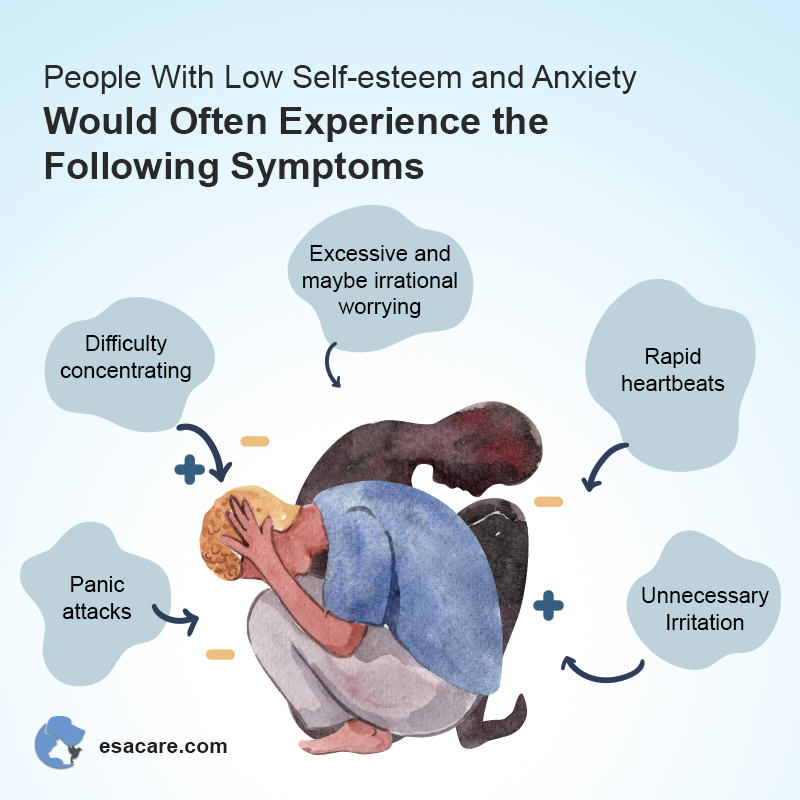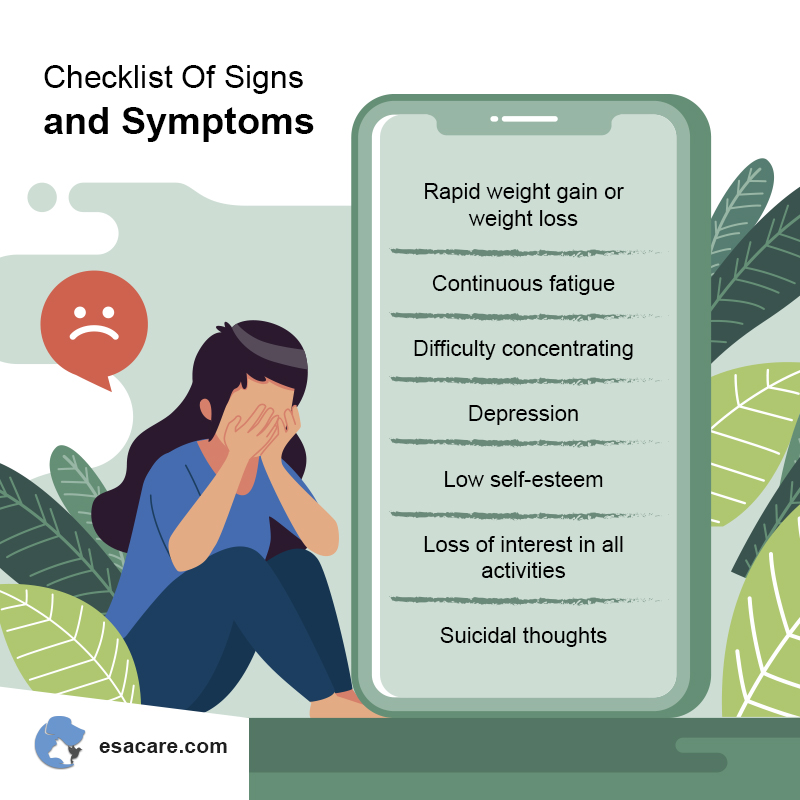How to Get an ESA Letter Online in 4 Easy Steps
If your search for an ESA letter has led you here, then I am happy to inform you that you’ve come to the right place!
Emotional Support Animals (ESAs) are pets that provide emotional support for people who struggle with psychological disorders. One of the requirements of getting an ESA is the ESA letter, which is essentially a certificate from a licensed medical health provider that permits you to have your ESA by your side in many different situations.
If you’re having mental health issues, get yourself an ESA Letter today!
If you thought that getting an ESA letter would be a lengthy and confusing process, think again!
It is ridiculously straightforward to get an ESA letter if you get the right information, exactly what this thorough guide seeks to give you.
So, without further delay, herein is everything you need to know about getting an ESA letter.
Table of Contents
Chapter 1: What is an ESA Letter?
An ESA letter can be described as an official letter from a licensed medical health professional (LMHP). It serves as a medical and legal document that protects the rights of psychologically afflicted people to access therapeutic mediums in the form of emotional support animals.
To obtain an ESA letter, you must first speak to an LMHP. Only these professionals can decide whether having an ESA is an appropriate form of therapy for the mental condition that ruins your life.
Most people think that getting an ESA letter is easy and that anyone can do it. Those people are wrong. The process of obtaining an ESA letter kicks off with an official diagnosis from an LMHP, who then determines whether you qualify for an ESA letter or not.

ESA Letter Advantages
To obtain an ESA letter, you must first apply for one, then submit it to a review by an LMHP. Once they have certified that you are struggling with mental illness, they can evaluate an ESA’s efficacy in treating your condition before establishing whether you qualify for an ESA letter.
As for who can qualify, read on to see some of the criteria used by LMHPs when issuing ESA letters.
Chapter 2: Who Prescribes ESA Letters?
To avoid confusion, you should note that only licensed healthcare providers can legally prescribe ESA letters.
The healthcare provider must be properly licensed to work and administer treatment in your state. So if you’re wondering who to talk to about getting an ESA letter, asking any of the five LMHPs we’ve just mentioned is a good place to start.
Remember that several people fall victim to scams from illegitimate health professionals and online sites that claim to issue ESA letters. Even if you’re in the presence of a trusted healthcare provider, make sure that you clearly explain what an ESA letter is, as some of them may not be familiar with it.
It helps if you allow the doctor to list off the treatment options for mental health issues, and if they don’t mention ESAs or ESA letters, you can bring it up.
Don’t be afraid to ask whether it is a viable treatment option for your case. This is especially necessary if you already have a pet that provides emotional reassurance by tolerating your low moods and cheering you up whenever they can.
Don’t wait anymore – Get your ESA letter in a few easy steps!
Ask the LMHP whether your pet can be considered an ESA; ESAs don’t need training.
If you feel like you don’t know enough to talk about this with your doctor, stick around as we go a little into depth about ESAs and ESA letters.
Chapter 3: How Does One Qualify for an ESA Letter?
Now that we’ve covered what an ESA letter is and who to talk to about it, let’s talk about the process of obtaining one. In this section, we will talk about what qualifies a person for an ESA letter.
We know that ESA letters are only administered to people that struggle with mental issues. The question is, what kind of mental issues are these?
-
Mood Disorders
Mood disorders, also called affective disorders, are critically underrated as serious mental health issues. They are characterized by severe mood swings that can change a person’s demeanor in an instant. They can be so severe that they affect a person’s daily life activities.
Some of the common mood disorders we know are clinical depression, bipolar disorder (I & II), and disruptive mood dysregulation disorder.
-
Eating Disorders
Erratic eating habits characterize eating disorders. They can swing both ways, from eating too much to eating too little. Either way, they can be very harmful to your health and even lead to irreversible damage.
Food provides nutrition crucial for the health and development of organs such as the brain, hearth, and lungs. Without a regular source of nutrition, these vital organs start to develop problems or fail altogether.

ESA Letter Prescription
Eating disorders can permanently disrupt a healthy individual’s normal appetite. What follows is drastic bodily changes. One can gain or lose a lot of weight rather quickly, which leads to alarming bodily changes within short periods of time.
Normally, people develop eating disorders in their teens. They include bulimia, anorexia, binge-eating, and rumination.
-
Anxiety Disorders
Anxiety cannot be categorized as a single type of mental illness. It encompasses several disorders that are all characterized by the classic nervousness displayed by anxiety patients.
Keep in mind that everyone feels anxious every once in a while. It doesn’t mean that you have an anxiety disorder. As an uncontrollable mental illness, anxiety can be severe and quite nerve-wracking.
A person with anxiety will be reluctant to talk to strangers or even to be in the presence of others in public. Their anxiety makes it impossible to talk to others, and over time, it starts to affect their ability to live normally, go to school, or even work.
Some common anxiety disorders are social anxiety disorder (SAD), general anxiety disorder (GAD), separation anxiety, panic attacks, and phobias.
-
Psychotic Disorders
This is an umbrella term that covers all mental health issues characterized by specific symptoms: psychosis.
It is important to remember that while psychotic disorders can be progressively managed, they can not be treated or cured outright. Managing such conditions gives the affected person the ability to perform daily activities that many take for granted. For instance, it may enable them to focus better, concentrate longer while studying, and maintain proper hygiene.
Psychotic disorders include schizophrenia, catatonia, delusion, substance-induced psychosis, and schizoaffective disorders.
Book an Appointment by clicking the banner below.
-
Personality Disorders
Personality disorders are mental conditions that alter the personality of the affected person. A person’s personality can be defined as what makes them unique from others. It entails their behaviors, thoughts, and feelings.
People with personality disorders tend to exhibit extreme personality changes, often in a concise amount of time. For example, a normally jovial and chatty person can suddenly turn gloomy and quiet for no apparent reason.
And when these personalities change, so do their likes and dislikes. If their favorite snack was ice cream, a shift in their personality could make them lactose intolerant even though personality changes occur in a span of minutes.
Young adults are the most commonly affected by personality disorder. Sadly, few get a professional diagnosis because most people attribute their personality disorder to normal teen angst.
Some common personality disorders are paranoia, avoidance, narcissism, histrionics, borderline personality disorder (BPD), and obsessive-compulsive disorder (OCD).
-
Post-Traumatic Stress Disorder (PTSD)
PTSD comes in the aftermath of an extremely traumatic event. People affected by PTSD routinely experience flashbacks, nightmares, and intrusive thoughts, often accompanied by severe anxiety attacks. No matter what they try, they find it hard, if not impossible, to escape the memories of the trauma they went through.
For example, someone who’s been in a bad car crash may experience flashbacks when they hear tires screeching or witness another accident. Some may even find it impossible to get back inside their vehicles.
PTSD may not seem like a big deal, but the reality is that it gradually grows worse until it overwhelms the individual’s life. If it is not addressed early enough, it may lead to acute stress, severe anxiety, phobias, insomnia, panic attacks, and isolation. Sadly, those that never receive any medical attention for their PTSD often resort to suicide.
Don’t let stress get to you – apply for an ESA letter now!
What next?
Now that you know the criteria that LMHPs use to decide who needs an ESA letter, you are capable of determining whether you or a loved one may benefit from having an emotional support animal.
The next chapter walks you through the simple process of obtaining an ESA letter online.
Chapter 4: Steps to Acquiring an ESA letter Online
Step 1: Self-evaluation
The first thing you must do is evaluate your current mental health condition to determine whether you will benefit from an ESA. The DSM-5 diagnostic criteria are widely used for self-evaluation tests.
If you have experienced five or more of the mentioned symptoms for more than two weeks, then you may have a positive diagnosis for a mental illness.
Proceed to the next step.
Step 2: Visit the health clinic’s website
If you’re looking for a way to get an ESA letter online, you must first visit a reputable health clinic website. Typically, these websites will require you to fill out a form before scheduling an appointment. In some cases, this form may be all you need to fill to acquire an ESA letter from an LMHP.

Symptoms of Anxiety
The form requires:
- Your basic information – Your full name, age, phone number, and address information may be requested to create a health profile if you’re a new patient at the health clinic.
- Information about your pet – If you don’t have a pet, it’s safe to skip this section. However, if you do, this is the part where you provide as many details about the animal you wish to turn into an ESA.
- Your medical history – You will be required to answer questions that will help the LMHP understand your medical history. For example, you will need to state whether there is a history of mental illness in your family.
Step 3: Booking an appointment
Once you’ve provided all the required information, you can now book an appointment. Pick a date you’re comfortable with, inform the hospital staff, and visit the LMHP on the specified date.
Step 4: Consultation
Depending on the healthcare center’s policies, you may be allowed to see the doctor in person or via video call. Both ways are appropriate for diagnosing mental health issues, so don’t be put off if the healthcare center restricts face-to-face appointments.
During the consultation period, the doctor will evaluate your mental and cognitive state using a series of verbal and visual tests. He or she will then ask you some questions about your lifestyle.
You must be clear, honest, and candid during the consultation period. The more information you give, the better the physician can diagnose your mental illness.
After the evaluation process, the LMHP will assess your report, and based on what they see, they will decide whether to administer an ESA letter or not.
This is the final step of the process.
Get an authentic ESA letter by clicking the button below!
Once you get an ESA letter, do things become different? Do you benefit in any way from having an Emotional Support Animal Letter?
We answer these and more questions in the final chapter of our helpful guide.
Chapter 5: Benefits of Getting an Emotional Support Animal
Over the last decade, the popularity of emotional support animals has skyrocketed. We attribute its growth in popularity to the increased awareness of the mental illness and the importance of mental healthcare.
Life is only getting more stressful, so more people are finding themselves in the grip of serious mental conditions. Mental health has been a serious topic in 2020 and will remain so for the foreseeable future. Conventional treatments are no longer as safe or as optimal as we previously thought.
Pharmaceuticals have grave side effects, and most of them can be habit-forming.
That is why having an emotional support animal is such wonderful alternative therapy for mental illnesses.
The benefits of owning an ESA surpass those of all other therapy forms, making ESA letter a necessity in this day and age.
Book an Appointment by clicking the banner below.
If you’re wondering how exactly you stand to benefit from having an ESA, here are some of the benefits:
-
Unlimited companionship
A common side effect of mental illness in isolation. People with mental disorders tend to feel like the odd one out and often withdraw into themselves to avoid any form of interaction with others.
The problem is, isolation only worsens mental illness. Even though the person may feel better when left alone, their condition only worsens with continued isolation.
That’s why having an emotional support animal can be crucial to recovering people with mental illness. Animals are naturally adept at reading human emotions. It’s an evolutionary trait that developed to allow them to live harmoniously with humans.
So, when you’re feeling depressed and want to be alone, your ESA will sense that. Instead of leaving you to cope on your own (like friends and family sometimes do), your furry support system will snuggle closer to you and use playfulness, cuteness, or just quiet companionship to help you get over those depressive feelings.
Animals can’t talk, but they sure know how to express themselves. ESAs will whine, purr, meow, or make any soothing sound that will get your attention and distract you from the bad feelings or thoughts that are plaguing you.
They will never judge you, complain, or ask for anything in return.
It is important for someone recovering from mental illness to have the constant support and unconditional love of a well-meaning entity. That’s where emotional support animals come in.
-
Protection from anxiety
Many mental illnesses are characterized by severe anxiety, especially in social situations. You must understand that anxious people cannot control how much or how often they worry.
When anxiety runs rampant, it can have dire implications on your mental and physical health.
Look at it this way: when you’re anxious, your blood pressure, heart rate, and breathing rate rise. If that happens too often, your blood vessels may become thick and stiff due to the high blood pressure. That gradually leads to restricted blood flow—this is where some of the major problems emerge.
Travel with your pet with an authentic ESA letter – Click the button below.
Restricted blood flow means less oxygen is delivered to vital organs like the kidneys and the brain. That’s why anxiety can even lead to cardiac arrest, stroke, and kidney failure!
Even though it is nearly impossible to control anxiety, it is entirely possible to distract an anxious mind. This is a feat that not many humans can accomplish without the help of an emotional support animal.
ESAs are naturally tweaked to sense anxiety attacks, inspiring them to capture your attention and distract your mind. When you start feeling anxious, your ESA reminds you that they are there to help you enjoy every second of life.
They are masters of artful distraction, especially since most ESAs are trained to become more interactive with their owners when they sense that they are in emotional distress.
These constant distractions will gradually train your mind to seek distractions every time you start getting anxious. With time, ESAs can make anxiety disorders very manageable.
-
Protection from phobias
What’s your phobia? Everyone has one.
People develop phobias of animals, objects, and situations, usually after undergoing traumatic experiences involving their source of fear.
Phobias can range from mild (such as arachnophobia, the fear of spiders) to the extreme (claustrophobia, the fear of enclosed spaces) to eccentric (pogonophobia, the fear of beards). While they may seem ridiculous to others, the people that suffer from these phobias take them very seriously.
Some unusual phobias that make it impossible for people to lead normal daily lives include alektorophobia (fear of chickens), technophobia (fear of technology), papyrophobia (fear of paper), and selenophobia (fear of the moon).
Fortunately, most of these phobias can be managed with the help of an ESA. The most important attribute that an ESA must possess is making you feel safe and protected. When you have an ESA around, you are better suited to face your deepest phobias and come out triumphant.
Besides, it is hard to pay attention to your phobias when your brain is flooded with endorphins. Whenever you interact with your furry buddy, whether it is going for walks, playing, or even taking them out for a trip to the fire hydrant, your brain releases the feel-good hormones we know as endorphins.
The best part is that you can talk to your ESA about your phobias, and they will patiently listen. They won’t embarrass you or ridicule you; they’ll be there for you. That’s a great way to get over your most irrational fears.

Signs and Symptoms
-
Dementia Management
Dementia may be portrayed as a problem that exclusively affects the elderly, but the reality is that anyone can get it. It is a common side effect of head injuries and trauma, so it can sometimes be witnessed in younger people.
Dementia causes partial memory loss, and since it is a chronic disease, it can only be managed, not cured. Though it is often treated using medicines and therapy, ESAs can effectively help manage symptoms of the disease such as paranoia, agitation, confusion, communication issues, an inability to perform simple tasks, memory loss, depression, and anxiety.
Even though extreme cases of dementia may require medical intervention, an ESA is still an optimal remedy for the mental condition. ESAs can prevent symptoms like depression and anxiety by providing comfort and familiarity to people living with dementia. It may also improve their ability to communicate and decrease their paranoia.
-
Autism Management
Autism is a mental condition that is commonly diagnosed in children. It can be detected from birth all the way to the first six months of the child’s life. The main symptoms of autism are the slower physical development of the affected child.
Kids with autism may take longer to utter their first words. They may also have trouble displaying affection, and they tend to struggle to communicate.
Most of the time, they detest physical contact and cannot make eye contact with anyone. They don’t know how to express their feelings and will not easily understand other people’s emotions. More prominent symptoms, like the repetition of words and actions and trouble adapting to new environments, may also be present.
ESAs can be essential therapy tools for kids with autism. Animals and children can develop a powerful bond. When children with autism start to trust their ESA, they may start exhibiting more affection, communication, and emotional awareness.
ESAs help these children to get in touch with their emotional nature. They can also teach them self-regulating techniques that help them calm down in uncomfortable situations.
Your ESA pet can be a great companion during a mental breakdown – Click the Button Below.
Bottom Line
Before you write off emotional support animals as a viable therapy for mental illnesses, consider the numerous lives they have changed. These thoughtful animals are a lifeline for people who struggle with mental health issues.
The only requirement is an ESA letter, which you must obtain from a licensed medical health professional. The ESA letter allows you to go with your ESA wherever you need them, even if local regulations restrict animals.
Once you get your ESA letter, you have the license to enjoy a beautiful, fun-filled life with your personal emotional support system.
Get your Emotional Support Animal Letter today by booking an appointment at ESACare.










 347 5th Ave Suite 1402-112,
347 5th Ave Suite 1402-112,

Leave a Reply
Want to join the discussion?Feel free to contribute!